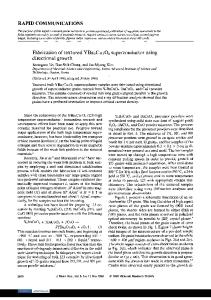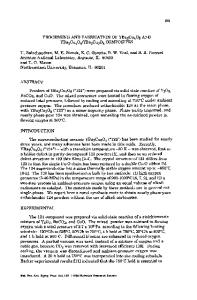Sintering of Textured YBa 2 Cu 3 O 7-x Under Intensive 60 Co Gamma Irradiation
- PDF / 319,059 Bytes
- 6 Pages / 414.72 x 648 pts Page_size
- 9 Downloads / 326 Views
it is of a great interest and importance to 723
Mat. Res. Soc. Symp. Proc. Vol. 354 @1995 Materials Research Society
investigate radiation-induced changes of the oxygen content in subsurface layers and weak links, keeping the cation network and oxygen content in the bulk unchanged. Such a situation can be realised in the case of gamma irradiation owing to radiation- stimulated sorption/ desorption of oxygen on the crystallite surfaces and intergrain contacts, and enhanced oxygen diffusion within the subsurface layer [4,5]. It becomes possible to find a correlation between the transport properties and oxygen depletion and disordering in subsurface layers. To investigate the role of the radiation-induced structure changes in the improvement of the current carrying capacity of YBCO ceramics, we used X-ray difraction analysis (XDA), scanning electron microscopy (SEM), and resistive (contact) and inductive (contactless) measurements of the
superconducting transition and the critical current density. EXPERIMENTAL RESULTS Samples of the standard ceramic YBa2Cu307-x with total oxygen content 6.87, a critical temperature of 90 K, a resistivity in the linear part before the transition, p = 1 mQ cm, and foreign phases < 1.5 %, and
also pellets pressed from the orthorhombic phase powder were irradiated by different doses within 104 - 109 R at dose rates of 100-3000 R/s and temperatures in the intervals of 300- 350 Kand 1200- 1250 K. XDA was done with the X-difractometer DRON-3M (USSR) using Cu koa radiation (1.54 A ). SEM photos were taken from the as-cleaved surfaces at magnifications 2000 and 15,000 to estimate an average size and shape of crystallites and intergrain links, - respectively. Un
L.
4-a U, .--
86 87 88 89 90
T (K) Fig. 1. Transition in YBCO ceramic gamma irradiated at 300 K.
Non-monotonous dose dependence of the resistivity at 100 K was observed: it decreased twice in the dose range of 104 - 106 R and then beginning from 107 R it increased by a power law. The value of Tc determined at a half of the transition amplitude did not change, however the temperature of zero resistance (the transition completion point) lowered by a few K (Fig.1). The transition measured by the inductive method at a frequency of 1 MHz did not change at all. The interdoublet distance at angles 20 = 46- 480, which indicates
724
1.0 0.5 0 0.5
0
WK
L"
U,
9 . +
'u
0Q5 _0+
•10
e
4,0
foIR
?.1
109R
O.S6 10'
mT
0
#4 [A
+6d.
o.,
, 30
28
30
26
, ,
,I
,I ,
28
26
2 Theta (degrees) Fig. 2. Gamma dose dependence of the reflection doublet (012)/(102). 725
the total bulk oxygen content, was constant within these doses. A noticeable decrease in X-ray background was observed at low doses, followed by an increase at high doses. Therefore the observed increase of p (100 K) and decrease of temperature of zero resistivity might be due to an oxygen depletion and amorphization of the surface layer and intergrain contacts. To check it we used the structure doublet of different indices (012)/(102) at 26 - 280. It was foun
Data Loading...











